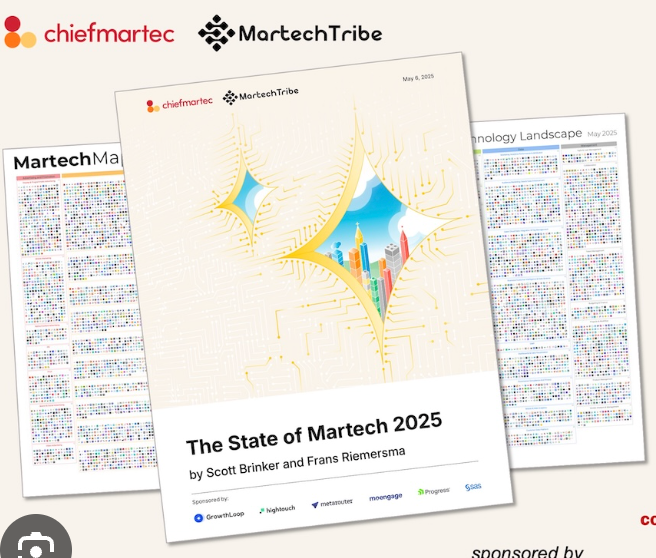Despite its dominance, Software-as-a-Service (SaaS) is showing signs of strain in the face of the AI tsunami.
Leading marketing technology consultant Scott Brinker, of Martec, says we marketers are all facing variations of the following challenges:
Subscription Fatigue: Companies are overwhelmed by the sheer number of SaaS subscriptions. Managing dozens of tools—each with its own pricing tier—creates complexity and cost creep. In Martech, this is acute, as teams juggle platforms for email, social, SEO, and more.
Diminishing Returns: Many SaaS tools promise innovation but deliver incremental improvements. Marketers often find overlapping features across platforms, leading to redundancy and inefficiency.
Integration Challenges: The dream of seamless SaaS ecosystems often falls short. Disparate tools require complex integrations, leading to data silos and workflow bottlenecks.
Market Saturation: The martech landscape is overcrowded. New entrants struggle to differentiate, and consolidation (e.g., Zuora’s $1.7B acquisition by Silver Lake and GIC in 2024) signals a maturing market.
Economic Pressures: Complex economic macros and tighter budgets in 2025 are pushing companies to scrutinize SaaS spending. CFOs are questioning the ROI of tools that don’t deliver measurable impact.
The Rise of SaaS
SaaS emerged as a game-changer in the early 2000s, driven by pioneers like Salesforce. By delivering software over the internet, SaaS eliminated the need for costly on-premise installations, enabling businesses to scale quickly and pay only for what they used. In Martech, this fueled an explosion of tools, covering everything from CRM to analytics and automation. The low barrier to entry empowered startups and enterprises alike, democratizing access to cutting-edge technology.
The appeal was clear:
- Cost Efficiency: Subscription models spread costs over time.
- Scalability: Tools could grow with a company’s needs.
- Accessibility: Cloud-based platforms allowed global, real-time collaboration.
For marketers, SaaS meant agility. Teams could deploy tools like HubSpot or Marketo to orchestrate campaigns, analyze data, and personalize customer experiences without heavy IT involvement.
The Fall of SaaS?
However the SaaS trajectory is shifting. Brinker argues that we’re entering a “post-SaaS” era, where the model evolves or gives way to new paradigms. Key trends include:
- Consolidation and Platforms: Mega-platforms like Salesforce and Adobe are absorbing smaller players, creating all-in-one suites. This reduces the need for multiple subscriptions but risks vendor lock-in.
- AI-Driven Automation: AI is reshaping martech, with tools embedding generative capabilities to automate content creation, analytics, and personalization. This could reduce reliance on specialized SaaS tools.
- Open-Source and Hybrid Models: Businesses are exploring open-source alternatives or hybrid solutions (e.g., self-hosted SaaS) to cut costs and gain control.
- Usage-Based Pricing: Some SaaS providers are shifting to pay-per-use models, aligning costs with actual value delivered.
What This Means for Marketers
For Australian businesses, particularly those leveraging martech, the evolving SaaS landscape demands a strategic rethink:
- Audit Your Stack: Review your SaaS subscriptions to eliminate redundancy. Tools like our consulting services can help optimize your martech stack.
- Prioritize Integration: Invest in platforms that integrate seamlessly or leverage APIs to connect your ecosystem.
- Embrace AI: Adopt AI-powered tools to streamline workflows and reduce dependency on multiple SaaS products.
- Negotiate Contracts: With market consolidation, negotiate better terms with SaaS providers to maximize value.
Looking Ahead
SaaS transformed martech, but its challenges—cost, complexity, and saturation—are undeniable. As Brinker notes, the future lies in smarter, more integrated solutions that prioritize outcomes over subscriptions. At MitchellMackey.com.au, we’re committed to helping Australian businesses navigate this shift, ensuring your martech investments deliver real results.
This post is adapted from Scott Brinker’s insights in the State of Martech 2025 report, co-authored with Frans Riemersma. For the full report and more Martech insights, visit chiefmartec.com or download the report at content.martechday.com/state-of-martech-2025.pdf.
Brinker’s key theme is that marketing has become a technology-powered discipline, and therefore marketing organizations must infuse technical capabilities into their DNA. I agree.



Leave a Reply